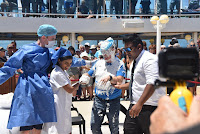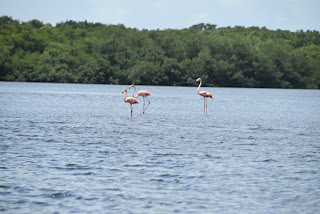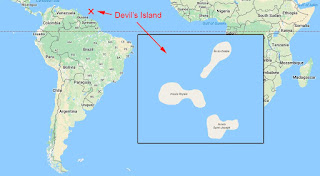Antigua and Barbuda are located in the centre of the Leeward Islands in the Eastern Caribbean. Antigua is the largest of the English speaking islands at 14 miles long and 11 miles wide. Barbuda is half the size. Total population of the two islands is only 100,000 people. Christopher Columbus named the island after the Church of Santa Maria de la Antigua in Seville, Spain. Originally, large scale sugar production was the main industry. In the 18th century, the British Royal Navy chose Antigua as its base and it has developed into one of Great Britain's most important military bases in the Caribbean. Now tourism, especially for beach lovers, is a main industry. There are over 300 pristine white sand beaches around the coast and many buses, vans and taxis ready to take the tourists to them.
Internet gambling and off shore banking are also part of the economy. We saw branches of The Royal Bank and Bank of Nova Scotia!
The shopping area at the port is lined with high end, duty free shops. Beyond that, the infrastructure deteriorated making walking hazardous.
The route to the cathedral, which has been under renovation of many years, was too challenging so we opted for beer instead.
Now it is time to think about packing suitcases and returning to the north. We have read that the sap is flowing, a sign that spring is almost here. Hurrah!
South America February 2020
Click on any photo in a post to view a larger version of that image
Thursday, March 5, 2020
Tuesday, March 3, 2020
Bridgetown, Barbados
Although the Caribs, Arawaks, and Portuguese had all inhabited Barbados, it was completely unoccupied when the British first settled here in 1627. Initially, the capital was Jamestown, named for King James I. Tobacco, sugar cane and ginger were the main crops, farmed using slaves. In 1960, the island gained independence but continues as part of the Commonwealth. The British roots are evident. Cricket is the main sport and afternoon tea is served daily.
Now the capital is the port of Bridgetown, a popular stop for cruise ships. Outside the capital, with its population of 110,000, the island boasts beautiful sandy beaches, sparkling aquamarine water and lush tropical hillsides.
Eighteen months ago we were in the Barbados. This time our time was spent walking along the waterfront on a pleasant warm morning. We visited the local fish market where we saw fishermen bringing in their catch of tuna and flying fish, a popular local treat.
Of course, the final stop was for the famous local beer at a cost of 3 for $5.00 US.
Now the capital is the port of Bridgetown, a popular stop for cruise ships. Outside the capital, with its population of 110,000, the island boasts beautiful sandy beaches, sparkling aquamarine water and lush tropical hillsides.
Eighteen months ago we were in the Barbados. This time our time was spent walking along the waterfront on a pleasant warm morning. We visited the local fish market where we saw fishermen bringing in their catch of tuna and flying fish, a popular local treat.
Of course, the final stop was for the famous local beer at a cost of 3 for $5.00 US.
Monday, March 2, 2020
Trinidad and Tobago
The island of Trinidad was discovered by Christopher Columbus on his third voyage in 1498. The natives were wiped out by the Spanish conquistadors and the island remained Spanish until 1797 when, along with Tobago, it came under British rule. Originally, plantations growing sugar cane and cacao using slaves were the basis of the economy. Slavery was abolished in 1845. In 1962, Trinidad and Tobago became an independent member of the Commonwealth.
Just seven miles off the coast of Venezuela, Trinidad and Tobago is one of the wealthiest and most developed nations in the Caribbean with a population of 1.4 million people. It is the 5th largest exporter of liquified petroleum gas. Also, asphalt is exported to the United States. We docked in Port of Spain, the capital city.
Just south of the city lies the Caroni Bird Sanctuary, the protected roosting site of the scarlet ibis, the national bird. Bird watchers flock to these islands which house over 450 species of birds. On our tour to the sanctuary we travelled through mangroves in a flat bottomed boat with an excellent guide.
 We saw a variety of birds, the crabs they eat, huge termite nests, and a boa contrictor. The red ibis was most visible flying overhead against the blue sky, although it could also be seen on the mangrove branches.
We saw a variety of birds, the crabs they eat, huge termite nests, and a boa contrictor. The red ibis was most visible flying overhead against the blue sky, although it could also be seen on the mangrove branches.
 The little blue heron and night heron were well hidden in the shadows. Tiny crabs climb up the aerial roots of the mangroves. The boa constrictor was curled up in a tree.
The little blue heron and night heron were well hidden in the shadows. Tiny crabs climb up the aerial roots of the mangroves. The boa constrictor was curled up in a tree.
There were lots of flamingos feeding on the mud flats. Our guide said that they came two years ago fom South America and are now native.
Arriving back at the port, we were hot and thirsty so we went in search of cold beer. we walked to Independence Square with a local who suggested this restaurant - a little local colour.
Just seven miles off the coast of Venezuela, Trinidad and Tobago is one of the wealthiest and most developed nations in the Caribbean with a population of 1.4 million people. It is the 5th largest exporter of liquified petroleum gas. Also, asphalt is exported to the United States. We docked in Port of Spain, the capital city.
Just south of the city lies the Caroni Bird Sanctuary, the protected roosting site of the scarlet ibis, the national bird. Bird watchers flock to these islands which house over 450 species of birds. On our tour to the sanctuary we travelled through mangroves in a flat bottomed boat with an excellent guide.
 We saw a variety of birds, the crabs they eat, huge termite nests, and a boa contrictor. The red ibis was most visible flying overhead against the blue sky, although it could also be seen on the mangrove branches.
We saw a variety of birds, the crabs they eat, huge termite nests, and a boa contrictor. The red ibis was most visible flying overhead against the blue sky, although it could also be seen on the mangrove branches. The little blue heron and night heron were well hidden in the shadows. Tiny crabs climb up the aerial roots of the mangroves. The boa constrictor was curled up in a tree.
The little blue heron and night heron were well hidden in the shadows. Tiny crabs climb up the aerial roots of the mangroves. The boa constrictor was curled up in a tree.There were lots of flamingos feeding on the mud flats. Our guide said that they came two years ago fom South America and are now native.
Arriving back at the port, we were hot and thirsty so we went in search of cold beer. we walked to Independence Square with a local who suggested this restaurant - a little local colour.
Saturday, February 29, 2020
The Salvation Islands
Off the coast of South America lies the small archipelago of Iles du Salut, Salvation Islands, consisting of three islands. The islands belong to the overseas department of French Guiana located on the north east coast of South America. Guiana has only 270,000 residents but, since it belongs to France, it is part of the European Union and is one of the most prosperous countries in South Anerica. One reason for the prosperity is a satellite launching station in Kourou from where nearly half of the world's commercial satellites are launched.
The three main islands, Royale, Saint-Joseph and Diable, were the site of the infamous "Devil's Island" penal colony from 1852 to 1953. An estimated 80,000 prisoners were sent to the islands and 75% of them died. Under the laws of the day, if the sentence was 4-8 years, the prisoner had to return to French Guiana for the same length of time at the end of the sentence before being eligible to return to France. If the sentence was greater than 8 years, the prisoner was sentenced to stay on the mainland in French Guiana for life. These laws were an attempt by France to build up the population of French Guiana as establishing the colony had been unsuccessful.
The largest of the islands is Ile Royale and was the reception centre for prisoners. Devil's Island mainly housed political prisoners, including Alfred Dreyfus who was unjustly accused of treason. His story was told in the Roman Polanski film "The Dreyfus Affair". Henri Charriere's book "Papillon", later made into a movie with Dustin Hoffman and Steve McQueen, described the harsh conditions experienced by the prisoners. The book is controversial as there are no records of Charriere being imprisoned on Devil's Island and escape by sea was almost impossible through the shark infested waters around the islands. It is believed that he served time in one of the prisons on land in Fench Guiana.


Today, Ile Royale houses a lighthouse, a church, a small hotel, and a pier where visiting boats can dock. St. Joseph, known for the most brutal conditions, has a few chalets and yachts anchored in the harbour.
Remnants of the prison buildings can be seen. There is a cemetery marking the graves of guards, their children and other family members. The prisoners' bodies were thrown into the sea to feed the sharks. Diable (Devil's Island) is privately owned and cannot be visited.
We cruised around the islands on a Sunday. We could see groups of people on catamarans who appeared to be on a day trip from the mainland. Many people were swimming, a sign (we hope) that the sharks are long gone!
The three main islands, Royale, Saint-Joseph and Diable, were the site of the infamous "Devil's Island" penal colony from 1852 to 1953. An estimated 80,000 prisoners were sent to the islands and 75% of them died. Under the laws of the day, if the sentence was 4-8 years, the prisoner had to return to French Guiana for the same length of time at the end of the sentence before being eligible to return to France. If the sentence was greater than 8 years, the prisoner was sentenced to stay on the mainland in French Guiana for life. These laws were an attempt by France to build up the population of French Guiana as establishing the colony had been unsuccessful.
The largest of the islands is Ile Royale and was the reception centre for prisoners. Devil's Island mainly housed political prisoners, including Alfred Dreyfus who was unjustly accused of treason. His story was told in the Roman Polanski film "The Dreyfus Affair". Henri Charriere's book "Papillon", later made into a movie with Dustin Hoffman and Steve McQueen, described the harsh conditions experienced by the prisoners. The book is controversial as there are no records of Charriere being imprisoned on Devil's Island and escape by sea was almost impossible through the shark infested waters around the islands. It is believed that he served time in one of the prisons on land in Fench Guiana.


Today, Ile Royale houses a lighthouse, a church, a small hotel, and a pier where visiting boats can dock. St. Joseph, known for the most brutal conditions, has a few chalets and yachts anchored in the harbour.
Remnants of the prison buildings can be seen. There is a cemetery marking the graves of guards, their children and other family members. The prisoners' bodies were thrown into the sea to feed the sharks. Diable (Devil's Island) is privately owned and cannot be visited.
We cruised around the islands on a Sunday. We could see groups of people on catamarans who appeared to be on a day trip from the mainland. Many people were swimming, a sign (we hope) that the sharks are long gone!
Friday, February 28, 2020
Crossing the Equator
According to the captain, we crossed the equator around 6:00 a.m. on our way to Trinidad and Tobago. However, the official ceremony took place around the pool at 11:00 a.m. King Neptune and his Queen held court for "Polliwogs", a few volunteers who may not have known what was coming.


Accused of a variety of crimes, including drinking only free wine and beer, being too amorous in their stateroom, and drinking all the gin and tonic on board, the polliwogs were annointed then forced to kiss the mackeral before jumping in the pool.
The crowd turned on the cruise director at the end and he also was forced to take a dip.
Five days "at sea" may be too many.
The captain addressed the gathering.


Accused of a variety of crimes, including drinking only free wine and beer, being too amorous in their stateroom, and drinking all the gin and tonic on board, the polliwogs were annointed then forced to kiss the mackeral before jumping in the pool.
The crowd turned on the cruise director at the end and he also was forced to take a dip.
Five days "at sea" may be too many.
Tuesday, February 25, 2020
Salvador, Brazil
In 1549, Portuguese explorers established Salvador as the first capital of colonial Brazil. It became the centre of sugar cane production, using slave labour, and the main slave trading port. Over 5 million slaves were transported from Africa to Brazil during the 19th century. The Afro-Brazilian culture strongly influences the religion, cuisine, music, and art today.
From the terminal, we walked to the Elevador Lacerda, which took us to Pelourinho, the historical centre of the city.


It is Carnival here as well. Although too early in the day for parades, there are signs of what is to come everywhere.
Salvador has over 165 churches as well as the largest assortment of Baroque architecture in Latin America.
Back at the lower level, our final stop was the African Market full of stalls selling fabric art, crafts and souvenirs. The temperature was 28 C (82 F) and the humidiy was high. We found cold beer to enjoy while listening to Afro Brazilian fusion music.
From the terminal, we walked to the Elevador Lacerda, which took us to Pelourinho, the historical centre of the city.


It is Carnival here as well. Although too early in the day for parades, there are signs of what is to come everywhere.
Salvador has over 165 churches as well as the largest assortment of Baroque architecture in Latin America.
 |
| Church of Our Lord of Bonfim |
Sunday, February 23, 2020
Buzios and Brigitte Bardot
Buzios is located on a small peninsula jutting out from the Brazilian mainland. French pirates discovered the area first and set up a lucrative business smuggling Brazilwood to Europe.

The Portuguese banished the pirates and established the town in 1575. With colonial architecture and cobblestone streets, trendy boutiques and fine restaurants, and over twenty beaches, Buzios has been called the St. Tropez of Brazil.

It was "discovered" in the 1960's by Brigitte Bardot when she visited with her Brazilian boyfriend. That discovery put the city on the tourist destination map for the beautiful people. Tourists line up to take a picture with her statue.
It was a lovely day for a stroll along the waterfront, a stop for drinks and a snack, then back to the ship by water shuttle as we prepare to leave for our next port of call.
Subscribe to:
Comments (Atom)























